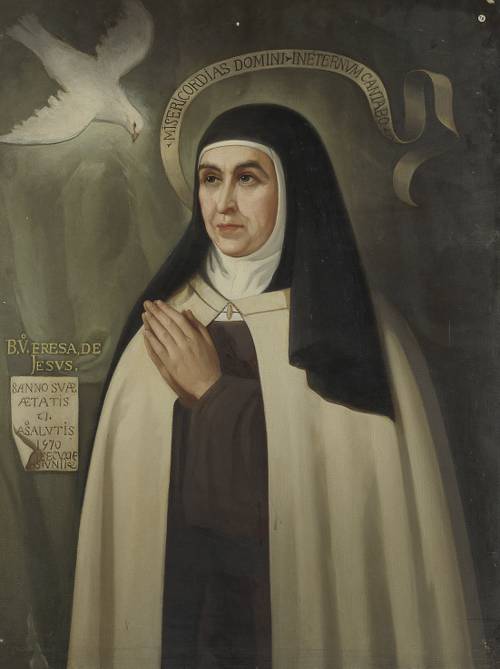
FAQ About Saint Teresa of Ávila

Who was Saint Teresa of Ávila?
Saint Teresa of Ávila was a Spanish mystic, writer, and prominent reformer in the Catholic Church. She was born on March 28, 1515, in Ávila, Spain, and is best known for her role in the formation of the Discalced Carmelites, a reform branch of the Carmelite Order. Teresa is celebrated for her spiritual writings and for being a significant figure in Christian mysticism.

What are some of Saint Teresa of Ávila's most notable works?
Saint Teresa of Ávila's most notable works include The Interior Castle and The Way of Perfection. These writings explore her mystical experiences and provide guidance on spiritual growth and prayer. Her works are considered classics in Christian spirituality and have influenced countless believers.

What is Saint Teresa of Ávila known for in the Catholic Church?
Saint Teresa of Ávila is known for her deep spirituality, her mystical experiences, and her role as a reformer of the Carmelite Order. She helped establish the Discalced Carmelites, emphasizing a return to a simpler and more contemplative form of religious life. Her contributions to Christian mysticism and her writings on prayer and meditation are highly respected in the Catholic Church.

When was Saint Teresa of Ávila canonized?
Saint Teresa of Ávila was canonized on March 12, 1622, by Pope Gregory XV. She was recognized for her deep spiritual insights, her contributions to the Catholic faith, and her efforts in reforming the Carmelite Order.

What is the significance of the Discalced Carmelites?
The Discalced Carmelites, founded by Saint Teresa of Ávila and Saint John of the Cross, represent a return to the primitive observance of the Carmelite life. The term "discalced" refers to going barefoot or wearing simple sandals, symbolizing a commitment to poverty and simplicity. The reform sought to renew the order's contemplative spirit and focus on a life of prayer and humility.

How did Saint Teresa of Ávila contribute to Christian mysticism?
Saint Teresa of Ávila contributed to Christian mysticism through her profound spiritual writings and personal mystical experiences. Her works, such as The Interior Castle, describe her deep union with God and provide a guide for spiritual development. Her teachings emphasize the importance of prayer, meditation, and a direct personal relationship with God, making her an essential figure in Christian mysticism.

What was Saint Teresa of Ávila's approach to prayer?
Saint Teresa of Ávila's approach to prayer was centered on mental prayer or meditation, viewing it as a means to achieve a deeper union with God. She believed that prayer should be a heartfelt conversation with God and emphasized the importance of inner reflection and contemplation. Her teachings on prayer aimed to help individuals grow closer to God through a personal, intimate relationship.

Why is Saint Teresa of Ávila considered a Doctor of the Church?
Saint Teresa of Ávila was declared a Doctor of the Church in 1970 by Pope Paul VI. She was recognized for her exceptional contributions to theology and Christian spirituality through her writings and teachings. Her insights into prayer, mysticism, and religious life provide significant guidance to believers and scholars alike.

What is an interesting fact about Saint Teresa of Ávila's life?
An interesting fact about Saint Teresa of Ávila's life is that she experienced mystical visions from a young age and maintained these experiences throughout her life. Despite facing various challenges, including illness and opposition to her reforms, she persisted in her mission and left a lasting impact on the Catholic Church.

How did Saint Teresa of Ávila reform the Carmelites?
Saint Teresa of Ávila reformed the Carmelites by establishing the Discalced Carmelites along with Saint John of the Cross. Her reforms focused on returning to the original austerity of the Carmelite Rule, emphasizing poverty, simplicity, contemplative prayer, and community life. She founded many convents built on these principles, significantly influencing the future of the Carmelite Order.

What challenges did Saint Teresa of Ávila face during her reforms?
During her efforts to reform the Carmelite Order, Saint Teresa of Ávila faced significant opposition from members of the Church and secular authorities resistant to change. She also struggled with health problems throughout her life. Despite these challenges, her determination and faith helped her to successfully implement her reformative vision.

Where is Saint Teresa of Ávila buried?
Saint Teresa of Ávila is buried in the Convent of the Annunciation in Alba de Tormes, Spain. Her relics are preserved there, and the site has become a place of pilgrimage for many of her followers and admirers.

When did Saint Teresa of Ávila die?
Saint Teresa of Ávila died on October 4, 1582. Her feast day is celebrated on October 15, commemorating her life and contributions to the Catholic Church and Christian spirituality.

What was the relationship between Saint Teresa of Ávila and Saint John of the Cross?
Saint Teresa of Ávila and Saint John of the Cross were close collaborators in the Carmelite reform movement. Together, they worked to establish the Discalced Carmelites, focusing on a more austere and contemplative mode of life. Their partnership was instrumental in advancing the reform of the Carmelite Order and has had a lasting impact on the Church.

How have Saint Teresa of Ávila's writings influenced modern spirituality?
Saint Teresa of Ávila's writings have greatly influenced modern spirituality by offering deep insights into personal prayer, mystical experiences, and spiritual development. Her approach to an intimate relationship with God through contemplation and meditation continues to inspire many in their spiritual journeys, making her teachings relevant even in contemporary spiritual practice.

What is 'The Interior Castle' by Saint Teresa of Ávila about?
The Interior Castle is one of Saint Teresa of Ávila's most famous works, written in 1577. It is an allegorical description of the soul's journey towards God, represented as a castle divided into seven mansions, each level signifying a stage of spiritual growth and closer union with the Divine. This book is a spiritual guide that continues to influence Christian mysticism worldwide.

What influence did Saint Teresa of Ávila have on the Catholic Church?
Saint Teresa of Ávila had a significant influence on the Catholic Church, particularly through her contributions to mysticism and her role in reforming the Carmelite Order. Her spiritual writings have shaped Christian contemplative practices, and her life's work inspired a renewal of religious fervor within the Church.

Is there a patronage associated with Saint Teresa of Ávila?
Yes, Saint Teresa of Ávila is the patron saint of headache sufferers and Spanish Catholic writers. Her deep spirituality and intellectual contributions have made her a popular figure among various groups seeking her intercession and inspiration.

What impact did Saint Teresa of Ávila's reforms have on female monastic life?
Saint Teresa of Ávila's reforms had a profound impact on female monastic life by empowering women within the Carmelite Order to pursue a simpler and more disciplined way of life focused on prayer and contemplation. Her reforms encouraged independence and a greater role in spiritual leadership, significantly improving the autonomy and influence of nuns during her time.

What was the historical context during Saint Teresa of Ávila's lifetime?
Saint Teresa of Ávila lived during a period of significant religious upheaval, marked by the Protestant Reformation and the Catholic Counter-Reformation. This era demanded reform and renewal within the Catholic Church, providing a backdrop for Teresa's efforts to promote spiritual and monastic reform. Her work coincided with these broader movements, positioning her as a key figure in Catholic renewal.
